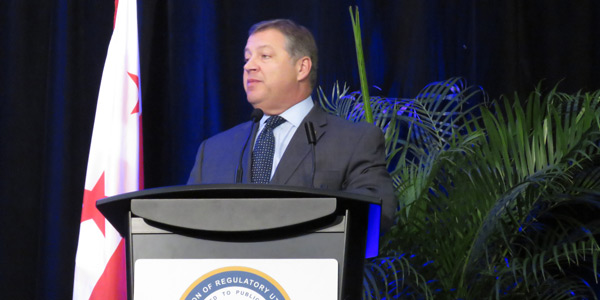WASHINGTON — A record 1,600 people attended the National Association of Regulatory Utility Commissioners’ winter meetings last week, where speculation about the Trump administration’s energy policies was Topic A. Here’s some of what we heard.
Infrastructure Bill Must Wait its Turn, House Transportation Chief Says

Rep. Bill Shuster (R-Pa.), chairman of the House Transportation and Infrastructure Committee, told NARUC’s General Session on Tuesday that he’s excited by the Trump administration’s call for expanded infrastructure spending but that a proposal won’t come until after Congress replaces the Affordable Care Act and develops a plan for overhauling corporate taxes.
“You’re not going to see the infrastructure package in the next month or two,” Shuster said.
“The order of things will be replacing Obamacare. … Tax reform will go next, and within that we have to figure out how to pay for infrastructure. It’s not all going to be federal dollars.
“One of our goals on the Republican side is to lower tax rates for corporations so they can keep more of their own money. So when it comes to pipelines and electric grid and broadband, let those corporations keep more of their money and then let’s get the regulatory barriers out of their way so that they can go build.”
Increasing the debt, he added, “is not an option in this Congress.”
Shuster said public-private partnerships can contribute but that the concept is “not the silver bullet … that some folks claim it is,” feasible only in instances in which private businesses can earn a return on their investments.
Uncertainty over Clean Power Plan Remains

Although the D.C. Circuit Court of Appeals is expected to rule soon on legal challenges to EPA’s Clean Power Plan, the ruling won’t be the last word, meaning RTOs and state policymakers will be facing uncertainty for the foreseeable future.
“If its upheld, then I think we’ll be looking to the new administration to make any proposals for change that they make and put them through the regulatory process,” acting FERC Chairman Cheryl LaFleur said. “It seems they’re going to make a change, but I am not privy to what it is.”
Arkansas Public Service Commissioner Ted Thomas noted that under the plan, the tougher emission targets — and increased costs — would hit in the second half of the next decade.
“The election didn’t change all that much about carbon risk,” he said. “If you’re saying, ‘OK, new administration, I don’t have to worry about carbon anymore,’ you might be making a mistake.
“Of course the elections are decided on issues non-energy related. We’re kind of like the flea that rides on the dog. The dog goes in the mud; we go in the mud with it. And if the next three years are like the last three weeks, we might be wishing we had the Clean Power Plan. There is real risk of federal policy that we deal with. We do that all the time. We’re state policymakers and federal policy takers.”
Crane Presses Case for Nukes, Calls for Unifying Environmental and Energy Policies

Exelon CEO Chris Crane agreed with NARUC President Robert Powelson, who said he had never seen a “more dynamic phase” in the electric industry.
“It’s a huge, huge issue to know where public policy is going to drive us,” Crane said during a panel discussion with leaders from the water, natural gas and telecommunications industries moderated by Powelson. “One of the more reliable baseload generating assets in the country, the nuclear assets, [face] significant challenges with current market design.”
Last year, officials in Illinois and New York approved controversial rescue plans for Exelon’s nuclear plants in their states. The zero-emission credit programs, which are being challenged in court and before FERC, recognized nuclear’s carbon-free production and the plants’ jobs and tax payments. (See IPPs File Challenge to Illinois Nuclear Subsidies.)
“This country for too long has separated an environmental policy from an energy policy, and [conflict between federal and state policies] has made it very difficult for markets to be formed efficiently and made it very difficult for predictability of investments going forward,” he said. “The leadership at the federal level [should] either come up with a common policy or get out of the way. Have the states be allowed to work with the RTOs and design the markets of state desires. The states we serve want affordable, reliable [energy], but they also want clean power. And how … you build a market signal around that to adequately compensate all the generators in the stack is very important.” (See related story, LaFleur Plans Tech Conference on State Generator Supports.)
He remained focused on the nuclear fleet, calling them “solid baseload units” and noted that they do not experience the issues that caused outages for 22% of PJM’s generation capacity during 2014’s extreme cold snap known as the polar vortex. Exelon’s nuclear units last year had a 95% capacity factor, he said.
“Renewables are an important part of the stack and they should continue to be part of the stack, but we need to look at defining outcomes. If the outcome is a higher-reliability, diverse fuel stack, then how do you create a market design that compensates for that?” he said. “It’s whatever the outcome is versus pitting technologies against technologies.”
He pointed to NOx, SOx and mercury emissions standards as successful governmental regulation. “It said, ‘here, fix your stack and clean up the air.’ The market took care of the rest. Some plants didn’t make it, some plants were built, some plants were modified,” he said. “Hopefully, with some clarity coming from this administration, some clarity coming from FERC, the states and the RTOs can do what they need to design a reliable, affordable and — where they want it — a clean stack.”
– Rich Heidorn Jr. and Rory D. Sweeney



